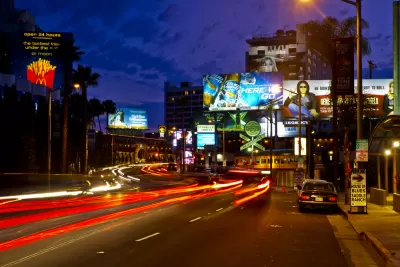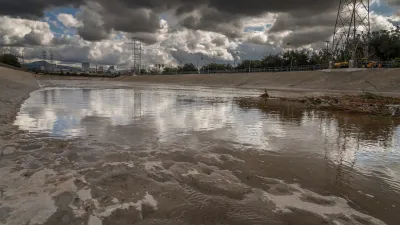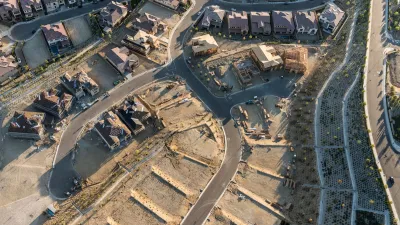Los Angeles appears in Blade Runner 2049 in name only. But the film still provides an arresting vision of a high-density future and is a reminder of the eternal ambiguity that surrounds Los Angeles.

"Blade Runner created a dystopic vision of Los Angeles that remains as culturally potent today — if not more so — than it was when it came out in 35 years ago. It shows up in books, articles, and offhand remarks with astounding regularity. It’s a testament to the arresting visuals of hyper-dense polyglot streets illuminated by sparkling advertisements and the possibility, however slim, that our sunny, spread-out paradise could, someday, become one of the dark places of the earth. After all, perhaps the biggest fantasy to come out of Los Angeles is Los Angeles itself."
"Areal shots depict the city’s familiar endless rows of boulevards and residential streets. The houses that dot Reyner Banham’s Plains of Id are replaced by high-rise shantytowns, made up of apartment buildings, each many stories tall, each more dilapidated than the last. Mere dingbats they are not. In this Blade Runner, the billboards walk the street, as 80-foot tall holograms that shake their asses just for you. (We’ve come a long way from Angelyne.) Skyscrapers rise into the ochre fog, and all is overshadowed by the new citadel of the Wallace Corporation, the corporation that rose from the ashes of Tyrell."
"Interestingly, of all the reasons that Scott might have envisioned for the demise of the world, climate change surely was not one of them. Blade Runner came out in 1982, after all. If anything, he probably had in mind the Cold War, signified by passing references to our them-communist antagonists, Russia and China. So, while the fictional city hasn’t changed much, its allegorical power has changed dramatically, as the real threats to humanity have evolved (and, arguably, worsened)."
FULL STORY: Searching for Los Angeles in Blade Runner 2049

Maui's Vacation Rental Debate Turns Ugly
Verbal attacks, misinformation campaigns and fistfights plague a high-stakes debate to convert thousands of vacation rentals into long-term housing.

Planetizen Federal Action Tracker
A weekly monitor of how Trump’s orders and actions are impacting planners and planning in America.

In Urban Planning, AI Prompting Could be the New Design Thinking
Creativity has long been key to great urban design. What if we see AI as our new creative partner?

King County Supportive Housing Program Offers Hope for Unhoused Residents
The county is taking a ‘Housing First’ approach that prioritizes getting people into housing, then offering wraparound supportive services.

Researchers Use AI to Get Clearer Picture of US Housing
Analysts are using artificial intelligence to supercharge their research by allowing them to comb through data faster. Though these AI tools can be error prone, they save time and housing researchers are optimistic about the future.

Making Shared Micromobility More Inclusive
Cities and shared mobility system operators can do more to include people with disabilities in planning and operations, per a new report.
Urban Design for Planners 1: Software Tools
This six-course series explores essential urban design concepts using open source software and equips planners with the tools they need to participate fully in the urban design process.
Planning for Universal Design
Learn the tools for implementing Universal Design in planning regulations.
planning NEXT
Appalachian Highlands Housing Partners
Mpact (founded as Rail~Volution)
City of Camden Redevelopment Agency
City of Astoria
City of Portland
City of Laramie





























